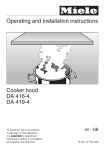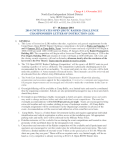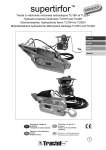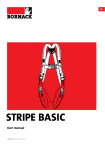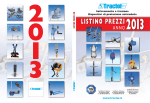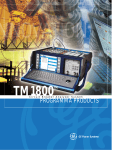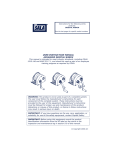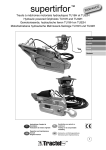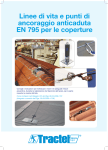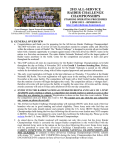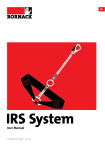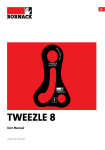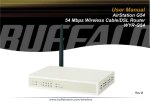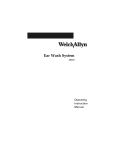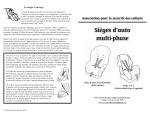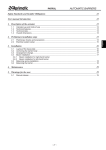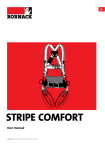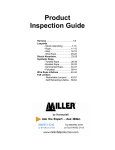Download derope® - Gravitec Systems
Transcript
derope ® emergency escape/controlled descent devices ANSI Z359.4-07 CSA Z259.2.3, type 1E use and maintenance instructions derope® emergency escape/controlled descent devices Contents Page First read the following warnings . . . . . . . . . . . . . . . . . . . . . . . . . . . . . . . . . . . . . . . . . . . . . . . .3 1. Function and description . . . . . . . . . . . . . . . . . . . . . . . . . . . . . . . . . . . . . . . . . . . . . . . . . . . . . .6 2. Limitation of the equipment . . . . . . . . . . . . . . . . . . . . . . . . . . . . . . . . . . . . . . . . . . . . . . . . . . . .8 3. System component requirements . . . . . . . . . . . . . . . . . . . . . . . . . . . . . . . . . . . . . . . . . . . . . . . .9 4. Installation . . . . . . . . . . . . . . . . . . . . . . . . . . . . . . . . . . . . . . . . . . . . . . . . . . . . . . . . . . . . . . . .10 5. Operation . . . . . . . . . . . . . . . . . . . . . . . . . . . . . . . . . . . . . . . . . . . . . . . . . . . . . . . . . . . . . . . . .12 6. Marking and labelling . . . . . . . . . . . . . . . . . . . . . . . . . . . . . . . . . . . . . . . . . . . . . . . . . . . . . . . .14 7. Maintenance and storage . . . . . . . . . . . . . . . . . . . . . . . . . . . . . . . . . . . . . . . . . . . . . . . . . . . . .14 8. Performance data . . . . . . . . . . . . . . . . . . . . . . . . . . . . . . . . . . . . . . . . . . . . . . . . . . . . . . . . . .16 9. Inspection . . . . . . . . . . . . . . . . . . . . . . . . . . . . . . . . . . . . . . . . . . . . . . . . . . . . . . . . . . . . . . . .16 10. Warranty information . . . . . . . . . . . . . . . . . . . . . . . . . . . . . . . . . . . . . . . . . . . . . . . . . . . . . . . .17 11. Inspection check list . . . . . . . . . . . . . . . . . . . . . . . . . . . . . . . . . . . . . . . . . . . . . . . . . . . . . . . .17 LIRE D'ABORD CET AVERTISSEMENT LEER ESTA ADVERTENCIA PRIMERO Il est essentiel pour sa sécurité que l'utilisateur comprenne intégralement le présent guide avant d'utiliser le dispositif. Une mauvaise compréhension de ce guide peut entraîner un risque mortel. L'utilisateur qui ne comprend pas couramment l'anglais doit recevoir l'information équivalente d'un spécialiste de la sécurité ou de son superviseur. Es necesario, para su propia seguridad, que el usuario lea y comprenda integramente este manual antes de utilizar el dispositivo. Si no se asimila bien este manual, puede tener como consequencia riesgo mortal. Si el usuario no comprende suficientemente el inglés, es necesario que tenga la información equivalente por parte de un especialista en seguridad o de su responsable superior. The Derope® emergency escape/contolled descent device is only part of a total fall protection system and the use of compatible hardware and components is mandatory. The system components must meet local, state, federal and provincial regulations before being incorporated in a personal fall protection system. It is imperative for the safety and efficiency of operations that this manual be read and fully understood by the worker before using any fall arrest system. ALL instructions contained herein must be carefully read and strictly followed for proper use and maintenance of the equipment. Alterations or misuse of this product, or failure to follow instructions can result in serious injury or death. If you have any concerns or questions, please contact your distributor or Tractel® Ltd. IN AN ENVIRONMENT WHERE A FALL HAZARD EXISTS, SAFETY IS A MATTER OF LIFE OR DEATH FOR WORKERS AND BYSTANDERS. This instruction manual is intended to meet the “Manufacturer’s Instructions” as required by ANSI and CSA and should be used as part of an employee training program as required by OSHA. It is neither a regulations compliance guide nor a general training guide for fall arrest, work positioning or travel restraint systems. You must refer to instructions delivered by manufacturers of the pieces of equipment included in your system. Whenever calculations and specific installations are required, the worker should be professionally trained to that end and should secure relevant information prior to commencing such work. FIRST READ THE FOLLOWING WARNINGS PRIOR INFORMATION I. It is the operator’s responsibility, and their employer’s responsibility if they operate under an employer’s control, to strictly conform to the following warnings and to the instructions in this manual. Doing otherwise would place any incident and its consequences under their responsibility. II. It is imperative, for safety and efficiency reasons, that this manual be read and fully understood by the operator before using the Derope® emergency escape/controlled descent device, and that all the instructions contained herein be followed accordingly. III. This manual should be available at all times to all users. Keep these instructions handy for easy reference whenever required. Extra copies are available from Tractel® Ltd. IV. Never operate the Derope® emergency escape/controlled descent device if any warning, operating or capacity instruction affixed to the device, as shown in this manual (Figure 15, page 15), are obscured or missing. In such case contact Tractel® Ltd. for supply of label or exchange of the unit (for stamped instructions) under commercial conditions. V. The emergency escape/controlled descent equipment must be placed under the authority of a competent person being fully trained and aware of the applicable safety regulations for use, maintenance, overhaul and control of the equipment for any professional use. VI. Equipment associated with the use of the Derope® emergency escape/controlled descent device must comply with applicable safety regulations, either local, state, federal and regional, and be compatible with one another and with the Derope® emergency escape/controlled descent device as described in this manual. This includes all parts that constitute the rescue equipment, especially the harness, lanyard, lifeline and connecting equipment. Tractel® Ltd. denies liability for any incident due to non compliance of components not sold or not recommended by Tractel® Ltd. TRAINING AND QUALIFICATION VII. Do not use the Derope® emergency escape/controlled descent device unless properly trained by an authorized trainer. A fall could result in serious injury or death. VIII. Health condition of the operator must be compatible with a possible fall arrest operation of the system used. IX. Before operating, a worker should be: a) Mentally and physically fit for the purpose, especially at heights or in confined spaces b) Free from the influence of alcohol or drugs c) Competent for the job to be performed d) Familiar with the equipment and all applicable safety rules, regulations and requirements e) Trained under safe conditions for working under the above requirements X. Training must be extended to maintenance, control and overhaul. It must be carried out under safe conditions excluding risk of fall. The training of the operator must be extended to a proper rescue procedure which must be set up in writing under the authority in charge of the equipment by a competent person or technical consultant according to work conditions. Contact Tractel® Ltd. for training information. 3 FIRST READ THE FOLLOWING WARNINGS CONTROL AND MAINTENANCE XI. The installation of the Derope® emergency escape/controlled descent device must be carried out under safe conditions according to the applicable local, state, federal and regional regulations. XII. The installation of the Derope® emergency escape/controlled descent device must be completed by a competent person to ensure that the anchorage is adequate, according to the applicable safety regulations, and that it can safely bear the dynamic loads applied in case of fall arrest. XIII. Every time the operator is to be connected to the rescue system, inspect the Derope® emergency escape/controlled descent device and the associated equipment. Ensure it is in good condition, as explained in this manual (section 9). Never operate the equipment if damage is detected. Check that the anchoring of the Derope® emergency escape/controlled descent device is safe and adequate for the load and the type of operation, according to applicable regulations. XIV. The operator must connect to the Derope® emergency escape/controlled descent device in a safe zone, away from any unprotected edge, in a safe and stable place for getting connected, according to the applicable safety regulations. XV. A careful and regular inspection of the Derope® emergency escape/controlled descent device and of the associated rescue equipment is part of the maintenance requirements for safe operation, especially under site conditions. Keep the device clean and free from dirt. Thorough overhaul servicing is available from Tractel® Ltd. XVI. Tractel® Ltd. declines any responsibility for the consequences of dismantling or altering the Derope® emergency escape/controlled descent device beyond description in this manual, by anyone who is not authorised by Tractel® Ltd. Tractel® Ltd. declines any responsibility for the consequence of repair having been carried out beyond its control. XVII. Except for the operations described in this manual, the maintenance and repair of Tractel® Ltd. equipment, must be exclusively performed by authorised (written approval) Tractel® Ltd. service center or by Tractel® Ltd. XVIII. Should the responsible authority decide that a piece of equipment is no longer suitable for use, take precautions in disposing of it so that it cannot be re-used. Satisfactory inspections should be entered in the provided inspection log. OPERATION 4 XIX. Always consider and control the specific risks related to the nature of the job that is subject to a rescue. XX. Ensure that the Derope® emergency escape/controlled descent device is properly secured to the structure before every operating session. The Derope® emergency escape/controlled descent device must be fastened with components specified by Tractel® Ltd. XXI. Prior to the use of the equipment described in this manual, it is imperative that you ensure that there are no obstacles within the evacuation trajectory or risk of contact with a dangerous surface. XXII. The Derope® emergency escape/controlled descent device must be positioned in a manner that will not interfere with the self aligment of the unit or prevent the proper rotation of the handwheel. The lifeline must be allowed to travel freely without any interference by the setup of the Derope® emergency escape/controlled descent device. FIRST READ THE FOLLOWING WARNINGS XXIII. Refer to the rescue plan put in place by the person responsible for the intervention site before using the device. XXIV. Tractel® Ltd. recommends that all operators/rescue workers be equipped with a communication device allowing them to issue an emergency signal in case of an incident. XXV. The Derope® emergency escape/controlled descent device must be used only for evacuation or rescue purposes, as described within this manual. No other use of the device is authorized. More specifically, the device must never be used as a suspension device or as part of a fall protection system. XXVI. The Derope® emergency escape/controlled descent device is designed to be used by one or two (1 or 2) persons. The combination of the user(s) weight, clothing and tools must not be less than 66 lbs. (30 kg) and must not exceed 500 lbs. (225 kg). XXVII. A maximum of two persons can be connected on one Derope® emergency escape/controlled descent device. The supporting structure must be adquate to bear the required efforts. XXVIII. Tractel® Ltd. assumes no liability for the adequacy of particular installations incorporating the Derope® emergency escape/controlled descent device, beyond the information and description given in this manual. IN CASE OF EVACUATION OR RESCUE XXIX. The rescue operation should not take more than 15 minutes. Longer delays may endanger the safety and health of the person to rescue. XXX. The rescue procedure must be carried out by rescuers trained in accordance with the rescue procedure, according to the fall arrest work environment. XXXI. The Derope® emergency escape/controlled descent device and associated equipment must be removed immediately after service. XXXII. Equipment must be returned to Tractel® Ltd. for inspection and re-verification. SYMBOLS AND CODE WORDS USED IN THIS MANUAL DANGER immediate or possibly imminent danger that will lead to serious injuries or death. WARNING immediate or possibly imminent danger that could lead to serious injuries or death. CAUTION possibly dangerous situation leading to minor or moderate injuries. NOTICE possibly dangerous situation leading to damage to equipment or surroundings. Always concerned to improve the quality of its products, the Tractel® Group reserves the right to modify the specifications of the equipment described in this manual. 5 Descent deceleration using the pig tail Arrest configuration using the jamming cleat Evacuation operation from cable car cabin Fig. 1 1. FUNCTION AND DESCRIPTION 1.3.2 1.1 Function The Derope® emergency escape/controlled descent device enables the evacuation or rescue of persons from an elevated position to the ground or a lower level at a controlled speed. The Derope® descent device is not to be used as a fall arrest system or part of a fall arrest system (Figure 1). Descent deceleration or arrest configuration By having the rope pass through the pig tail, the rescue worker can manually decrease and even stop the descent action. To lock the device, simply insert the rope trough the jamming cleat. This feature is standard on all Derope® descent device models from Tractel® Ltd. (Figure 2). 1.3.3 Attachment feature 1.2 6 Fig. 2 Description The Derope® descent device is composed of a Kernmantle® rope that goes through the reinforced casing where a centrifugal brake limits the descent speed. Snap hooks located at each extremity of the rope allow for accelerated evacuations. Pig tails and a jamming cleat give users even more control on the descent speed. Cooling fins ensure that the unit is rapidly available for consecutive descents. 1.2.1 The descent speed is automatically limited to 235 ft./min. (72 m/min.) for a single user through the operation of the centrifugal brake. 1.3 Features 1.3.1 Hoisting or lowering function This feature allows a victim to be lifted by the rescue worker with the help of the hand wheel equipped with a folding handle. Lifting speed is 3 ft./min. (1 m/min.). This option is available on the Derope® Up A, Up E and Up R descent device models. 1.3.3.1 Derope® T and Derope® Up A These devices can be attached by a carabiner located on top of the device (Figure 3 and 4). 1.3.3.2 Derope® Up E This device comes equipped with a bracket designed to stabilise the Derope® Up E descent device on a ladder. The bracket locks onto two rungs and must be anchored with the use of an adjustable lanyard (Figure 5). 1.3.3.3 Derope® Up R This device comes equipped with a bracket designed exclusively for the Tracpode™ positioning tripod from Tractel® Ltd. This bracket must be fastened to one of the legs of the tripod with the fastening pin (Figure 6). 1.4 Accessories 1.4.1 Carryring bag The carrying bag is designed to house the Derope® descent device with up to 330 ft. (100 m) of rope. This bag allows for easy access to the equipment as well as easy Adjustable lanyard to secure the system Rope adjuster Carabiner Pig tail Carabiners Pig tail Jamming cleat Casing Upper clamp jaw Kernmantle® rope (Descent extremity) Anchor pin Lower clamp jaw Kernmantle® rope (Ascending extremity) Index device Self-locking snap hook Knurled knob Derope® T Fig. 3 Derope® Up E Fig. 5 Hand wheel Rope blocking device Folding handle Rope guide Safety pin Locking screw Fastening pin Fig. 4 Derope® Up A Fig. 6 Derope® Up R 7 transportation in the event of an intervention or rescue situation. 1.4.2 In-line pulley Pulley equipped with two aligned sheaves, designed for evacuation on a tensioned rope. 1.4.3 Rigging plate The rigging plate is used to fasten several connectors to a single fastening point. The plate allows for orienting and distributing the load during rescue operations. 1.5 Technical specifications See Table 1 below. 2. LIMITATION OF THE EQUIPMENT 2.1 Maximum two workers per Derope® descent device. 2.2 Capacity The Derope® descent device is rated to be used with a minimum of 66 lbs. (30 kg) and a maximum of 500 lbs. (225 kg). The combination of the user(s) weight, clothing and tools may not exceed 500 lbs. (225 kg). 2.3 Descent For repeated descents, use of the Derope® descent device is limited with respect to load, descent height, and number of repeated descents in accordance with the limits indicated in the table below. See Table 2 below. DANGER Only the Tractel® Ltd. Kermantle® that comes with the device is authorized for use with the Derope® descent device. This rope can be customized for lengths ranging from 30 to 1,300 ft. (10 to 400 m). DANGER Following each use, whether for a single descent or repeated descents, the Derope® descent device must be inspected by a technician trained and qualified for this operation. Table 1 Model Derope® T Derope® Up A Max. height for single descent Derope® Up E Derope® Up R 1 person: 1,300 ft. (400 m) 2 persons: 650 ft. (200 m) Speed of descent 1 person: 235 ft./min. (72 m/min.) 2 persons: 295 ft./min. (90 m/min.) Temperature -31 to 122° F (-35 to 50° C) Dimensions (H x L x D) 6 ⁄16 x 4 ⁄32 x 4 ⁄8 in. 8 ⁄64 x 77⁄8 x 61⁄2 in. 1929⁄32 x 107⁄16 x 61⁄2 in. 193⁄32 x 107⁄16 x 61⁄2 in. (170 x 120 x 105 mm) (225 x 200 x 165 mm) (485 x 265 x 165 mm) (485 x 265 x 165 mm) Construction Housing: aluminum casting Internal parts (pulley and gears): heat-treated steel Hand wheel winch 11 23 1 55 n/a n/a Max load: 310 lbs. (140 kg) Applied force: 11 lbs. (5 kg) Capacity 1 person: 310 lbs. (140 kg) 2 persons: 500 lbs. (225 kg) Weight 4 lbs. (1.9 kg) 6.6 lbs. (3 kg) 13.4 lbs. (6.1 kg) 3 Kernamntle rope 14.3 lbs. (6.5 kg) ⁄8 in. (9.5 mm) Tractel Ltd. Kernmantle ® Standards ® ® ANSI Z359.4-07 and CSA Z259.2.3, type 1E Table 2 Maximum number of repeated descents Descent height 8 < 165 ft. (50 m) < 410 ft. (125 m) < 650 ft. (200 m) < 1,000 ft. (300 m) < 1,300 ft. (400 m) Capacity of 310 lbs. (140 kg) 16 6 4 2 2 Capacity of 500 lbs. (225 kg) 6 2 1 1 Prohibited DANGER The combined descent height must be monitored. If the combined descent height exceeds the limits indicated in Table 2 below, regardless of the time taken to reach this combined descent height, the descent device must be overhauled as instructed in section 9 by a technician trained and qualified for this operation. 2.3 2.4 Corrosion The Derope® descent device has been designed with corrosion resistant materials. However it should not be left for long periods of time in environments where corrosion could take place. If corrosive environments such as sewage, fertilizer or seawater are unavoidable, increase frequency of inspections to ensure that the integrity of the rescue equipment remains uncompromised. Electrical hazards Take extreme caution when working near or around high voltage power lines: electricity can pass through the metal components of the equipment resulting in electrocution. 2.5 Explosive environment The Derope® descent device is not to be used in a potentially explosive environment. 2.6 Temperature The Derope® descent device is intended for use in an environment ranging from -31° to 122° F (-35° to 50° C). 2.7 Chemical hazards The user is responsible for keeping the lifeline out of exposure to damage such as chemical hazards and/or abrasion. 2.7.1 Each application should be evaluated taking into consideration the following: a) type of acid/alkali b) exposure conditions c) concentration d) temperature 2.7.2 Paint can penetrate into the weave and dry, causing the rope to become hard, brittle and eventually break the fibers. Solvents and drying agents within paint cause damage similar to chemical exposure. 2.7.3 Exposure to chemicals may cause equipment malfunction. If your equipment will be exposed to chemicals and you are unsure of the effects on your equipment, please contact Tractel® Ltd. 2.8 Moving machinery Take extreme caution when working near or around moving machinery. 2.9 Sharp edges/Abrasion Contact with sharp edges or abrasive surfaces should be avoided. Cushion or otherwise protect against product contact. 2.10 Sunlight All organic fibers, either natural or man-made, will degrade to various degrees from exposure to ultraviolet light. Precautions should be taken to store equipment away from prolonged exposure to sunlight, fluorescent lights and other source of ultraviolet radiation. 2.11 Product life Any Derope® descent device showing excessive wear or degradation shall be removed from service and returned to an authorized dealer for inspection. See inspection information (section 9) for further information. 3. SYSTEM COMPONENT REQUIREMENTS 3.1 Environmental hazards must be considered in selecting the appropriate lifeline, harness and lanyard. Questions about using the Derope® descent device where chemicals, high temperature or other unusual conditions exist should be addressed to Tractel® Ltd. 3.2 Anchor system An anchorage point is a secure point of attachment for a personal fall arrest system. It must be identified by a qualified or competent person. It has to be independent of Make sure there is no obstacle in the evacuation path Fig. 7 9 the means of supporting the worker. For rescue purposes, the anchorage point must support a minimum of 3,100 lbs. (13.8 kN) per attached worker. Consult local, state, federal and provincial regulations as revisions occur. Fig. 8 Every anchorage point must be selected with care. Make sure that there are no obstacles in the evacuation path and on the landing zone. Maintain a safe distance from any obstruction to ensure a safe descent (e.g. electric wires, glass, concrete reinforcing bars) (Figure 7). 3.2.2 Never use an anchorage point which will not allow the snap hook keeper to close. Anchor must be compatible with snap hook and must not be capable of causing a load to be applied to snap hook keeper. Before each use, ensure that all connectors are in good working condition and safely closed, especially the gates on the snap hook and/or carabiner. 4. INSTALLATION Derope® Up E mounted on ladder a. b. Index pin c. 3.2.1 WARNING The Derope® descent device must only be installed and used by a trained technician. d. 4.1 Derope® T and Derope® Up A emergency escape/controlled descent devices An inspection as per section 9 must be performed before use. 4.1.1 Identify or prepare the anchorage point for the Derope® descent device. 4.1.2 Make sure that the anchorage point can withstand a minimum of 3,100 lbs. (13.8 kN) and is located above the evacuation point. 4.1.3 Attach the Derope® descent device to the anchorage point with the help of the supplied carabiner. 4.1.4 Throw the rope down, making sure that there are no entanglements or knots, that the rope does not come in contact with sharp edges and that it reaches the ground. 4.2 Derope® Up E emergency escape/controlled descent device Inspect the ladder uprights and rungs for signs of deformation. 4.2.1 Set up the upper clamp jaw onto the ladder rung at the desired position to perform the rescue (Figure 8a). 4.2.2 Bring the lower clamp jaw up to the closest rung (Figure 8b). Fig. 9 Fig. 10 10 Derope® Up R mounted on tripod 4.2.3 Thighten in place using the knurled knob located on the side of the bracket (Figure 8c). 4.2.4 Install the adjustable lanyard: a) Run the adjustable lanyard through the ladder structure located above the device, going around one of the uprights and an upper rung at the same time (Figure 8e). b) Connect the lanyard onto the rope adjuster (Figure 8f). c) Pull on the rope to tighten around the anchoring structure. WARNING The Derope® Up E descent device must always be secured with an adjustable lanyard on a separate anchorage point. Ensure the ladder has sufficient load bearing capacity. 4.2.5 Throw the rope down, making sure that there are no entanglements or knots, that the rope does not come in contact with sharp edges and that it reaches the ground. 4.2.6 Align the Derope® descent device in the required direction by modifying the position of the anchor pin in the indexing device (Figure 9). 4.3 Derope® Up R emergency escape/controlled descent device 4.3.1 4.3.2 The Derope® Up R descent device must be attached to one of the legs of a Tracpode™ positioning tripod from Tractel® Ltd. as shown on Figure 10. Any other form of attachment to the Tracpode™ positioning tripod is prohibited. In order to use the Derope® Up R descent device on one of the three legs of the Tracpode™ tripod, the latter must be equipped with a diverter pulley or two (2) pulleys if another piece of equipment is used on the same Tracpode™ tripod (e.g.: Blocfor® self-retracting lanyard or work winch). 4.3.3 To install the Derope® Up R descent device on the Tracpode™ positioning tripod from Tractel® Ltd., set up the equipment by following these instructions: a) Unscrew the screw securing the hook by which the bracket is fastened to the Derope® Up R descent device (Figure 11a). b) Install the Derope® Up R descent device on the fastening hook (Figures 11b and 11c). c) Screw in the locking screw to prevent the unit from separating from its bracket (Figure 11c) and check that it is properly positioned and tightened. 4.3.4 When the Derope® Up R descent device is installed on the bracket used with the Tractel® Ltd. Tracpode™ tripod: a) Lay the Tractel® Tracpode™ tripod folded on the ground. b) Adjust the legs of the Tractel® Tracpode™ tripod to obtain the desired height: see user manual for Tracpode™ tripod. c) Choose the leg on the Tractel® Tracpode™ tripod carrying an idler pulley at the top; withdraw the locking pin from this leg. d) Position the bracket rigging hole in line with the locking hole on the Tractel® Tracpode™ tripod. CAUTION Caution with respect to assembly direction: the rope blocking device must be pointing towards the top of the Tracpode™ tripod (Figure 10). e) Install the fastening pin for the bracket used with the Derope® Up E descent device. The fastening pin ensures two functions: lock the Tracpode™ tripod leg and secure the bracket for the Derope® Up R descent device on the tripod leg (Figure 12a, page 12). f) Lock the fastening pin using the safety pin (Figure 12b, page 12). g) Fully unfold the three legs of the Tracpode™ tripod. Fig. 11 11 h) Remove the ball pin located above the idler pulley at the top of the Tracpode™ tripod (Figure 12c). i) Run the rope of the Derope® descent device around the idler pulley (Figure 12d). j) Fit the ball pin to prevent the rope from coming out of the idler pulley (Figure 12e). k) Open the rope blocking device on the bracket (Figure 12f). l) Insert the rope coming out of the Derope® descent device in the rope blocking device of the bracket (Figure 12g). m) Throw the rope down, making sure that there are no entanglements or knots, that the rope does not come in contact with sharp edges and that it reaches the ground. n) Close the rope blocking device (Figure 12h). 5. OPERATION 5.1 Before use Functionally check the Derope® descent device by manually pulling the rope in the device over a minimum length of 3 ft. (1 m) in both directions to make sure that the resistance during movement increases with the speed of movement. Fig. 12 12 WARNING Always use a self-locking snap hook for an attachment in any personal rescue system. 5.2 Evacuation function During a intentional vertical evacuation, the person must not move away by more than 20° with respect to the vertical axis to avoid any excessive swinging effects. The anchor point must be above the evacuation area. 5.2.1 After you have installed the Derope® descent device in compliance with the instructions in section 4, proceed as follows: a) Fasten the person to be evacuated or hook yourself up by the connector at the end of the evacuation strand of the Derope® descent device to a fall-arrest harness. b) Pull the free strand of the rope to tension the evacuation strand. c) Run the free strand of the rope through the rope guide then through the jamming cleat. d) If necessary, check that the handwheel handle on the Derope® Up descent device models is folded in. e) Place the person to be evacuated above the open space. The person will not descend since the rope is blocked by the jamming cleat. f) Start the descent by releasing the free strand of the rope in the jamming cleat. g) Descent may be interrupted by firmly grasping the free end of the lifeline. h) Once the person has reached the ground, unfasten the person from the harness. i) Position the other end of the lifeline taut with no slack before attaching to the next person to descend. j) Ensure the Derope® descent device has properly cooled before its next use. 5.3 5.4 5.4.1 Evacuation on a cableway descent If it is not possible to evacuate the victim vertically due to an obstruction, the evacuation can be carried out down a cableway positioned at an angle between 30° and 60° (Figure 13). a) The rescuer secures two anchor slings to the structure. The higher anchorage to be used for the cableway and the lower point for the Derope® descent device. b) Attach the victim to the descent rope of the Derope® descent device and to the cable way using the 1-ft. (30 cm) lanyard. c) Two persons on the ground tension the cableway in the direction of travel to avoid any obstructions. d) Release the descending rope from the jamming cleat and monitor the descent until the victim is on the ground. Hoisting or lowering function After the Derope® decent device has been properly secured above the victim as described in section 4, the self-locking snap hook at the extremity of the rope must be hooked into the frontal or back D-ring on the full body harness of the victim and secured. WARNING Ensure that the free end of the Kenmantle® rope is inserted in the jamming cleat. 5.4.2 The handle is folded out from the handwheel and the handwheel is then rotated in the ‘UP’ or ‘DOWN” direction in order to hoist or lower the victim to a safe recovery platform or up to a point where the victim can be released from his fall protection sub-system. 5.4.3 The rope located in the jamming cleat must be kept tight during the hoisting of the victim with the hand crank in order to prevent an unintentional descend. 5.4.4 Fold the handle back into the handwheel. Pull the rope located in the jamming cleat out of the jamming cleat and lower the victim. Pig tail Derope® Ascending end of the Derope® Descending end of the Derope® Lanyard The rope between the device and the person to be lowered/hoisted must not have any slack; the free rope on the other side must be pulled downwards with force. The free end of the trailing rope is inserted in the aluminium pig tail so that it can be clamped in the jamming cleat. 30° to 60° Fig. 13 Fig. 14 13 5.4.5 The rope removed from the jamming cleat must be guided during the evacuation process by allowing it to lightly slip through the hand. The rope must be lead through the friction diverter during the whole evacuation process. 5.4.6 The descending speed will be controlled automatically by a centrifugal brake. It is also possible to interrupt the descent by braking (holding) the upward travelling trailing rope with the hand. 5.5.5 Both persons can now evacuate by releasing the rope being held. The descending speed will be controlled automatically by a centrifugal brake. It is possible to interrupt the descent by holding the ascending trailing rope by hand. 6. MARKING AND LABELLING 6.1 Read and comply with all markings and/or labels on the Derope® descent device. The markings and/or labels must be intact and easy to read. 6.2 The Derope® descent device is marked and/or labelled as shown in Figure 15. WARNING It must be ensured that the ascending rope does not catch or hook on an obstacle as this would consequently interrupt the evacuation process. Ensure that the person(s) do not collide with an obstacle during the descent. WARNING Never remove a label from a piece of equipment. 5.5 5.5.1 Simultaneous recovery of victim and rescuer The simultaneous evacuation of two persons allows a victim to be lowered under accompanying supervision (Figure 14, page 13). The rescuer can descend simultaneously with the victim when the rope reserve is already located on the ground. This process is only permitted up to a maximum evacuation height of 650 ft. (200 m). 5.5.2 Both persons to be evacuated must wear a full-body harness. 5.5.3 Upon anchoring the Derope® descent device to a structural element with a sufficient loadbearing capacity, the rescuer ensures the trailing rope is passed into the friction diverter, so it can be clamped in the jamming cleat, and descends to the victim while controlling the trailing rope. 5.5.4 Upon reaching the victim, the rescuer attaches the victim’s back D-ring to his own frontal attachment point using a 1-ft. (0.3 m) lanyard. Upon ensuring of the proper connection holding the victim to the rescuer frontal attachment point, the rescuer can cut the victim’s lanyard from it’s anchorage point. DANGER Prior to releasing the fall protection sub-system, usually a shock-absorbing lanyard, ensure the victim is properly connected to the extremity of the evacuation rope. 14 7. MAINTENANCE AND STORAGE 7.1 Failure to maintain and store equipment carefully can result in damage and malfunction that could lead to serious or fatal injury. 7.2 Storage The rescue equipment should be stored in a dry and cool room and protected from UV light. Avoid contact with acids, caustic liquids and oils. Prior to storing rope ensure it has been dried without any exposure to direct heat. 7.2.1 Prior to storing the rescue device an inspection is recommended to allow a quicker access when required. Upon meeting inspection requirements the device should be stored in an equipment bag that would prevent external deterioration and allow proper transportation to required site. The bag should be “locked” in a manner to prevent any tampering and ensure all the rescue equipment is ready for use. 7.3 Cleaning Most of Tractel® Ltd.’s equipment can be washed with a solution of cold water and mild detergent. After washing and brushing with a synthetic brush, rinse thoroughly with clear water and hang to dry, out of the sun and away from exposure to high heat. Metallic equipment such as the Derope® descent device and carabiner must be dried thoroughly to avoid corrosion. Items can be washed whenever needed to extend their lives. They will also be easier to inspect for damage. Do not use any cleaning solvent agents, acids etc. as they may seriously damage the equipment. Fig. 15 15 8. PERFORMANCE DATA 8.1 Capacity The Derope® emergency escape/controlled descent device is designed to be used by one or two (1 or 2) persons. The combination of the user(s) weight, clothing and tools must not be less than 66 lbs. (30 kg) and must not exceed 500 lbs. (225 kg). 8.2 Requirements The Derope® descent device meets ANSI Z359.4-07 and CSA Z259.2.3, type 1E. 8.3 Anchorage strength requirements 3,100 lbs. (13.8 kN). 8.4 Maximum allowed single descent height Up to 1,300 ft. (400 m) for one person and up to 650 ft. (200 m) for two persons. 8.5 Maximum allowed consecutive descent height See Table 2, page 8. 8.6 Nominal descent speed 235 ft./min. (72 m/min.) for one person and 295 ft./min. (90 m/min.) for two persons. 8.7 Hoisting/lowering height with hand wheel The maximum hoisting/lowering distance with hand wheel winch is 165 ft. (50 m). 9. INSPECTION 9.1 Inspection schedule A thorough inspection of the working components is required by Tractel® Ltd. or an authorized service center upon meeting one of the following critiria: a) One person: up to 3,280 ft. (1,000 m) b) Two persons: up to 1,000 ft. (300 m) c) Hoisting/lowering distance with hand wheel winch: 165 ft. (50 m) remove the item from service immediately and replace it. If any damage or questionable conditions are apparent and are not described below, remove the item from service, replace it and contact Tractel® Ltd. for advice. 9.2.1 If corrosive environments are unavoidable or the units are to be used for training, increase frequency of inspection to ensure that the integrity of the system and its components remains uncompromised. 9.2.2 Failure to remove equipment that has been damaged or is in questionable condition could lead to serious or fatal injury. A detailed record of inspection should be maintained. See pages 18 and 19 for suggested record sheets. 9.3 Devices at training facilities When the Derope® descent device system is used for training, greater care must be taken to ensure the inspection is performed thorougly by a competent person at the end of each training day, even if the aforementioned limit values for the inspection intervals were not reached during the previous training. WARNING Training courses and exercises Only trained competent personnel authorised by Tractel® Ltd. may implement training courses and exercises. 9.4 Components 9.4.1 Hardware and housing All parts of the hardware, bracket and housing should be inspected for rough or sharp edges, corrosion, burrs, cracks dents and distortion. Ensure the presence of all screws and that they are properly tightened in position. 9.4.2 Rope entry and exit points The wear at the rope entry/exit point must be checked. The rope entry/exit point must not show a wear greater than 5⁄64 in. (2 mm). 9.4.3 Handwheel The handwheel should rotate freely without resistance and turn evenly in the horizontal plane without any wobble. 9.4.4 Carabiner All parts of the carabiner should be free of corrosion and distortion. The gate spring should exert enough force to firmly close the gate. Special attention must be paid to the mechanism, which should close adequately. The safety bar of the autolocking carabiner must complete its rotation when closed. WARNING All stated limit values for the inspection intervals apply only for devices and ropes that do not show signs of wear. The above limits can be achieved by the cummulation of use. Consideration must be given not to surpass the above limits, inspections should be performed prior to reaching the limits and prior to storing the units for a next use. 9.2 16 A visual inspection must be completed prior to each use. A competent person must inspect all equipment periodically, at least once a year and log all information relating to the inspection. If damage is detected as described below, 9.4.5 9.4.6 Rope The rope must be visually/manually inspected along its entire length for the following wear appearance/defects/damage; Cuts, broken fibers, thickening, fraying, kinks, knots, rot, burns, severe wear/abrasion, open, loosened termination and sheath displacement (Figures 16 and 17). The diameter must be constant along the entire lenght of the rope. Fibre breaks Check that the Derope® descent device has the required potential for the number of consecutive descents, descent height and evacuation load to carry out the operation planned: see Table 2, page 8. WARNING Discoloration, fused, melted or brittle fibers may indicate signs of chemical solvent, burning heat or ultraviolet damage. 9.5 Fig. 16 GOOD NOT GOOD Fig. 17 10.5 Any defect in this equipment must immediately be brought to the attention of Tractel® Ltd. The distributor will make arrangements with the factory for repairs or replacements of the parts within the terms of this warranty. 10.6 Tractel® Ltd.'s obligation is restricted to replacing parts and does not include the complete unit. The warranty is void on any unit that has been modified or tampered with, repaired by persons other than a factory representative or an authorized Tractel® Ltd. distributor, repaired with other than Tractel® Ltd. standard parts, or damaged by reasons of accident, alteration, misuse or abuse. 10.7 This warranty is in lieu of all other warranties, expressed or implied. We do not authorize any person or representative to make any other guarantee or to assume for us any liability in connection with the sale of our appliances other than those contained herein. Any agreement outside of or contradictory to the foregoing shall be void and of no effect. 11. INSPECTION CHECK LIST 11.1 Inspection log for training facilities The performed descending work must be entered into the attached list for documentation purposes. A differentiation between descending and hoisting must be made. For every other component, refer to appropriate inspection instructions. WARNING Any equipment that fails to meet the above inspection requirements shall be removed from service. Only Tractel® Ltd. or persons or legal entities authorized in writing by Tractel® Ltd., shall make repairs to Tractel® Ltd. rescue equipment. 10. WARRANTY INFORMATION 10.1 Tractel Ltd. warrants its equipment to be free from defects in material and workmanship under normal use and service. 10.2 Our obligation under this warranty is limited to repairing or replacing, at our option, any part of the unit, which proves under examination to our satisfaction, to be defective in material or workmanship. The item in question is to be returned to Tractel® Ltd. upon authorization of the distributor, transportation prepaid, within twelve (12) months from the date the equipment was sold to the original purchaser. Return shipment must be prepaid. ® 10.3 Any parts proved to be defective, upon inspection by Tractel® Ltd. will be repaired or replaced at no cost. 10.4 The obligation under this warranty does not include labor or transportation costs or consequential damages of any kind. Severe rope wear, wear with rope thickening 17 Derope® decent device model: Serial number of the manufacturer: Owner/User: Date of purchase: Date of inspection 18 First use: Inspection results, details of identified defects Signature of competent person Derope® decent device model: Product serial number: Owner/Training facility: Date of use Result of visual inspection Evacuation Hoisting height height and and weight of weight of trainee trainee Trainer/User Trainer’s signature Maximum number of repeated descents Descent height < 165 ft. (50 m) < 410 ft. (125 m) < 650 ft. (200 m) < 1,300 ft. (400 m) Capacity of 310 lbs. (140 kg) 16 6 4 2 Capacity of 500 lbs. (225 kg) 6 2 1 Prohibited 19 Contact the nearest Tractel® Ltd. office. In the United States 1 800 561-3229 110 Shawmut Rd. P.O. Box 188 Canton, MA 02021 Tel.: (781) 401-3288 Fax: (781) 828-3642 In Canada (626) 937-6727 315 Cloverleaf Dr., Bldg E Baldwin Park, CA 91706 Tel.: (626) 937-6727 Fax: (626) 937-6730 fallstop@tractel.com 1 800 561-3229 11020 Mirabeau St. Montreal, QC H1J 2S3 Tel.: (514) 493-3332 Fax: (514) 493-3342 www.tractel.com Fallstop® is a registered trademark of Tractel®. Ref. 3912CD (P0000)-v03-0000-06/09 © 2009 Tractel® Printed in Canada




















